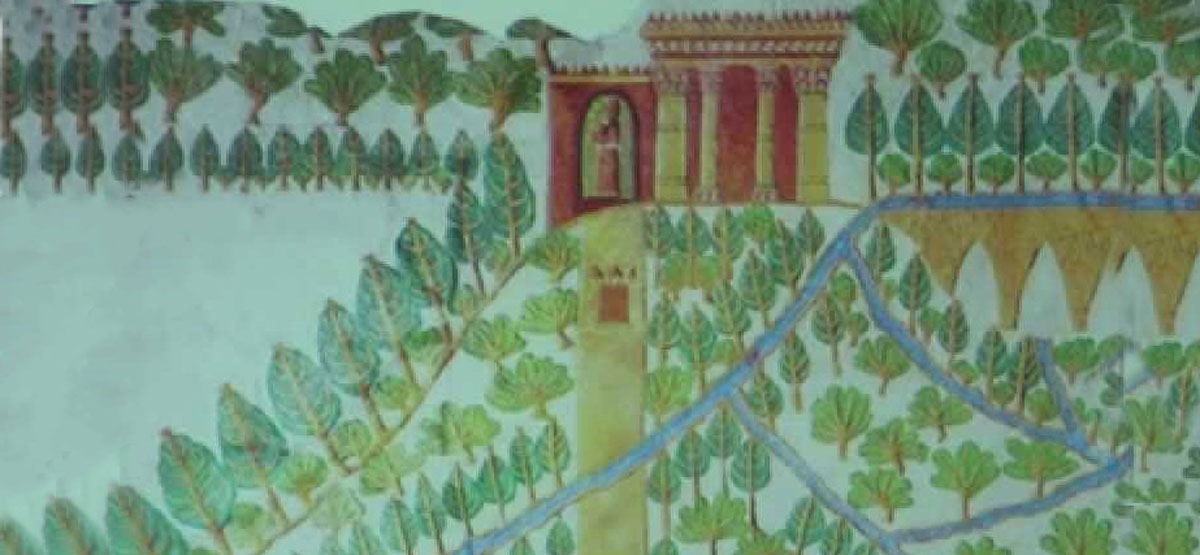The Persian Gardens are a series of gardens and landscapes that were designed and built in Iran from the 6th century BCE to the present day. These gardens are known for their unique design, which includes water features, geometric patterns, and a variety of plants and trees. The Persian Gardens are not only beautiful but also have significant cultural and historical value. They are a testament to the skill and ingenuity of the Iranian people and are recognized as a UNESCO World Heritage Site.
The Persian Gardens are an important part of Iran’s cultural heritage, and they reflect the country’s long history of horticulture and garden design. They also have significant symbolic and spiritual meaning, representing the idea of paradise on earth and the importance of nature in Iranian culture. The gardens have influenced garden design and architecture around the world, and they continue to inspire artists, designers, and gardeners today.
Visitors to Iran can explore several Persian Gardens inscribed by UNESCO World Heritage, including the Pasargadae in Marvdasht Fars, Eram in Shiraz, Chehelston in Isfahan, Fin in Kashan, Abbasabad in Tehran, Shazdeh Garden in Mahan Kerman, Dolatabad in Yazd, Pahlavanpur in Mehriz Yazd, and Akbarieh in Birjand.
Whether you are a garden enthusiast, a history buff, or simply looking to experience the beauty of Iran, the Persian Gardens are a must-see destination.
To visit Persian Gardens, don’t hesitate to look into our Iran World Heritage Tour.
1- Pasargadae Gardens | The Oldest of Persian Gardens Ever
Pasargadae Persian Garden is a section of the Pasargadae World Collection referred to as the Origin of Persian Gardens and the Early Gardening Pattern of Iran. Based on historical evidence, Cyrus the Great described how to make the gardens, and even how to arrange the trees. These gardens also had large buildings and other small gardens, and many see it as a “garden in the garden.”
Today, nothing remains of the ancient beauty of this garden, but evidence and discoveries show that the garden has two mansions, various trees, colorful flowers as well as numerous birds; elements that Cyrus the Great designed to his own taste.
The water needed for the royal garden was provided through the branches of the Pulvar River. One of the interesting points of this garden is its water circulation system on rocky land.
Read also: Bisotun: A Window into Ancient Persian History
2- Eram Garden in Shiraz | the Masterpiece of Persian Gardens
Located in northwest Shiraz, Eram Garden is a beautiful example of Persian gardens that have withstood the test of time in both cold and warm weather. Although the garden’s origin and creator remain unknown, it has been documented in travelogues dating back to the 10th and 11th centuries. Over the years, the Eram garden has undergone multiple changes and expansions, and it currently spans a vast area of 110,380 square meters, featuring a large pool, water circulation system, and lush greenery.
The garden’s mansion boasts upper-floor columns inspired by the iconic Persepolis, adding to its beauty and magnificence. Visitors can also admire the various paintings adorning the walls, including depictions of Naser-al-Din Shah Qajar, stories from Ferdowsi’s Shahnameh or Epic of Kings, Suleiman and Queen Saba, Rostam, Khosrow Shirin, Yusuf and Zulikha, and ancient Persian literature and religious tales. Eram Garden is a must-visit destination for those looking to explore the beauty and history of Persian gardens and their cultural significance.
Read also: The Armenian Monastic Ensembles in Iran: A World Heritage Site
3- Shazdeh Garden in Mahan | An Emerald in Desert
The Prince Garden or Shazdeh Garden is a green place in the city of Mahan, Kerman province, which shines like a green oasis in the middle of Lut desert. The history of the spectacular Shazdeh garden dates back to the Qajar era and it was built on the orders of Mohammad Hassan Khan, Sardar Iravani, the ruler of Kerman. Water in the prince’s garden comes from the Qanat and the Tigran River, which originates from the snowy mountains of Mount Jupar. This water comes from the highest part of Shazdeh garden and flows through the amazing distribution and irrigation system to water diverse and uplifting trees.
Shazdeh Garden is such an attraction you cannot miss. The courtyard, the mansion, the pool and the beautiful streams that look like small waterfalls have given a special atmosphere to this place. In addition to its historical background, the garden is also eye-catching. People come together for various occasions such as the New Year and spend some time there.
Read also: Bam Citadel: A Cultural Treasure of Iran
4- Chehelsotun in Isfahan | Not Only a Palace but a Persian Gardens
When people hear the name of Chehel Sotoun, everyone remembers the building with its majestic pillars and imagines the palace in mind, but the garden inside which Chehelsoton mansion is built is much more worthy as its name appears on the UNESCO World Heritage List. Chehelsotun Garden in Isfahan is a wisely-built garden with beautiful aisles and a water circulation system. Its nice mansion which is now a museum attracts the attention of its visitors. There is a large pool in the garden and the reflection of the mansion image makes such a unique opportunity for photography. Sculptures placed around the pool are another interesting part of this garden.
Read also: Bisotun: A Window into Ancient Persian History
5- Fin Garden in Kashan | A UNESCO-inscribed Persian Garden
Fin Garden or the Garden of Shah located in Kashan is a green and beautiful area. Fin Garden, inside its high walls, is completely separated from the city’s atmosphere. The presence of aqueducts and karizes provides the needed water for this garden.
The garden is 33700 square meters, covered by the barrow and cylindrical towers where the residents were in complete safety against the rain. The size, shape and height of the building also reflected the glory and majesty of its royalty. The murder of Amir Kabir – Iran’s Chancellor – the most important event in Iran’s history, has taken place in the bath of this garden adding to its reputation.
There are about 579 cypress and 11 arboreal trees in the garden, most of which are between 100 and 470 years old. Beautiful pools and fountains along with the eye-catching buildings created such a relaxing atmosphere that allows you to enjoy the natural beauties when relaxing.
A striking feature of this garden is the pond in which people throw coins and believe their wishes will be fulfilled. The philosophy of dropping a coin in water returns to the ritual of Mitra in the Zarathustra religion. In this ritual, water is a symbol of purity, so one has to give a part of the wealth to the goddess and takes blessings instead.
Read also: Shushtar Historical Hydraulic System: An Ingenious Feat of Engineering
6- Abbas Abad Persian Garden in Behshahr | The Only Garden in North Iran
Abbas Abad Historical Complex or Abbas Abad Garden is a beautiful space in Alborz Mountains, which is considered to be the most important non-desert garden in Iran. This valuable collection was built by Shah Abbas I in 1020 and 1021 AH and now it reaches 500 hectares. The garden of Abbas Abad is located on a natural hill. The Safavid Engineers created its stairs and platforms by cutting down the hill, and then they built a three-storey garden with a beautiful mansion at its highest point.
Like many other Persian gardens, mirror works are a part of the architecture of this garden which adds to its beauty. An interesting feature of this garden is the paved roads as a part of this vast complex. The water supply of the garden consists of 600 meters long clay pipes distributing water to all parts of the garden.
The mansion, observation towers, north and south plains, dam and water flow control tower, and pottery workshops are interesting parts of this garden.
Read also: Exploring Uramanat: a unique blend of Architecture, nature, history, and Culture
7- The Persian Garden of Dolatabad in Yazd | Host The World’s Tallest Windtower
Doulat Abad Garden, which was built at the end of the Afshari period, is considered one of the most beautiful gardens in Iran. The garden has four main buildings. Several parts of this garden have been destroyed over the years, and today only 40,000 square meters of it remain. Doulat Abad Garden has two distinct sections at the moment.
The main reason for its reputation is the tall wind tower known as the world’s tallest wind tower. This wind tower is located above the entrance hall (summer mansion) directing the desert breeze into the building. In this garden like other Persian gardens, water plays an important role; the water was provided by the Doulat Abad historical aqueduct. This aqueduct is one of the most important and longest aqueducts in the city of Yazd, which has five fields and originates from Mehriz Highlands.
Read also: Gonbad-e Qabus Tower: A Unique Symbol of Iranian Heritage
8- The Persian Garden of Akbarieh In Birjand
The Akbarieh Garden, located in the city of Birjand, is another Persian garden with an area of 45,000 square meters. Historical evidence suggests that Akbarieh gardens and mansion started to be constructed during the late Zandiyeh or early Qajar era, and finished during the Qajar era. This garden is located in a mountain bed and covered by adobe walls from three sides.
The architecture of this garden is Persian, but inspiration comes from Russian architecture integrated with Islamic architecture, all created modern architecture. The spaces in this garden include the Heshmat al-Mulk mansion, the central mansion and the service spaces. There are also museums inside the garden displaying the history and culture of this part of Iran. These museums include Birjand Archaeological Museum, Birjand Museum of Anthropology, Doll Museum and Khorasan Culture Museum.
Read also: Shahr-e Sukhteh: The Burnt City of Ancient Iran
Due to the flowing of water inside it, Pahlavan Pour was an attractive garden from the late Qajar period. Most of the water in the garden is directly provided by Hasaabad Qanat, and this water, except for the Pahlavan Pour, does not directly go to any of the gardens in the area. Shah Hoseini Qanat is another source of water supply.
The old trees are one of the attractions of this garden, located on two sides of the main garden. Pomegranates, almonds and persimmons are the fruit trees of this garden that give a special character to this place.
In terms of architecture, many experts believe that Pahlavan Pour Garden shows the progress of ancient Iranian gardening into present-day gardening that has of particular importance in this regard.
It is interesting to know that the entrance of this garden is decorated in the Zand period style, but its construction dates back to the Qajar era.
Read also: Soltaniyeh Dome: A Masterpiece of Iranian Architecture




